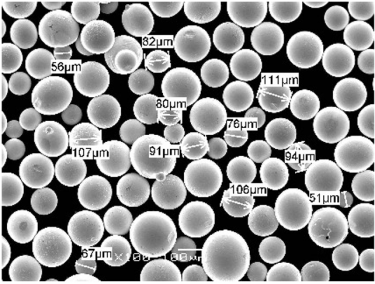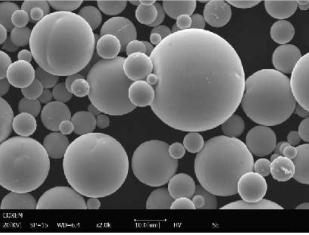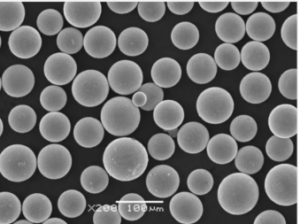Einführung in Metallpulver
Was wäre, wenn ich Ihnen sagen würde, dass die geheime Soße hinter diesen röhrenden Raketenmotoren nicht nur der Treibstoff ist, sondern auch die Materialien, aus denen sie hergestellt sind? Ja, Sie haben richtig gehört! Metallpulver, diese winzigen Partikel metallischen Glücks, sind das Herzstück von Hochtemperatur-Raketentriebwerke.
Aber was genau sind Metallpulver, und warum sind sie so wichtig? Stellen Sie sich ein Metall vor, das so fein gemahlen ist, dass es einer Staubwolke ähnelt. Das ist Metallpulver für dich! Aber lassen Sie sich nicht von ihrer winzigen Größe täuschen. Diese Pulver sind die Bausteine für einige der hitzebeständigsten, haltbarsten und leistungsstärksten Komponenten in der Luft- und Raumfahrtindustrie.
Ob Nickel, Titan, Aluminium oder sogar einige der exotischeren Refraktärmetalle - jede Art von Metallpulver bringt einzigartige Eigenschaften mit sich. Bei diesen Pulvern handelt es sich nicht um beliebige Materialien, sondern um perfekt entwickelte Werkstoffe, die den harten Bedingungen der Raumfahrt und darüber hinaus standhalten.
Lassen Sie uns nun tiefer in die spezifischen Arten von Metallpulvern eintauchen, die in Hochtemperatur-Raketentriebwerken verwendet werden, und sehen, wie sie zum nächsten großen Sprung für die Menschheit beitragen.
Arten von Metallpulvern, die in Hochtemperatur-Raketentriebwerken verwendet werden
Bei Raketentriebwerken sind nicht alle Metallpulver gleich. Jeder Typ hat seine eigenen Eigenschaften, die ihn für verschiedene Teile des Triebwerks geeignet machen. Sehen wir uns einige der Hauptakteure in diesem Spiel mit hohen Einsätzen an.
- Pulver auf Nickelbasis
- NiCrMo (Nickel-Chrom-Molybdän): NiCrMo ist für seine hervorragende Korrosionsbeständigkeit und Hochtemperaturstabilität bekannt und wird häufig in Brennkammern und Turbinenschaufeln verwendet.
- Inconel 718: Inconel 718 ist eine Superlegierung, die Temperaturen von bis zu 700 °C standhalten kann. Sie wird wegen ihrer Kriechfestigkeit und ihrer Fähigkeit, die mechanische Festigkeit in extremen Umgebungen zu erhalten, sehr geschätzt.
- Pulver auf Titanbasis
- ti-6al-4v: Diese Legierung ist aufgrund ihres unglaublichen Verhältnisses von Festigkeit zu Gewicht ein Superstar in der Luft- und Raumfahrtindustrie. Sie eignet sich perfekt für Strukturbauteile, die sowohl leicht als auch langlebig sein müssen.
- Ti-Al-Nb (Titanium-Aluminium-Niobium): Diese Legierung ist für ihre Oxidationsbeständigkeit und Hochtemperaturfestigkeit bekannt und wird häufig für den Bau von Motorgehäusen verwendet.
- Pulver auf Aluminiumbasis
- AlSi10Mg (Aluminium-Silizium-Magnesium): AlSi10Mg ist leicht und dennoch stabil und wird häufig für die Herstellung von Treibstofftanks und anderen Strukturkomponenten in Raketentriebwerken verwendet.
- AlCu4Mg1 (Aluminium-Kupfer-Magnesium): Aufgrund ihrer hervorragenden Bearbeitbarkeit und Wärmeleitfähigkeit wird diese Legierung häufig für Wärmetauscher und Kühlsysteme verwendet.
- Pulver aus hochschmelzenden Metallen
- Tungsten (W): Der Schmelzpunkt von Wolfram von 3422°C macht es zu einem erstklassigen Kandidaten für den Einsatz in Düsen und anderen Hochtemperaturbereichen von Raketentriebwerken.
- Molybdän (Mo): Molybdän ist ein weiteres Refraktärmetall und wird für Bauteile verwendet, die hohen Belastungen und Hitze ausgesetzt sind, ohne sich zu verformen.
- Pulver auf Kobaltbasis
- CoCrMo (Kobalt-Chrom-Molybdän): Diese Superlegierung ist besonders für ihre Verschleißfestigkeit bekannt und wird für Hochtemperatur-Kugellager und -Dichtungen verwendet.
- Stellit 6B: Eine Kobalt-Chrom-Legierung mit hervorragender Hitze- und Korrosionsbeständigkeit, die sich ideal für Ventilsitze und Auslassventile eignet.

Zusammensetzung und Eigenschaften von Hochtemperatur-Metallpulvern
Hauptmerkmale von Metallpulvern in Raketentriebwerken
Was macht diese Metallpulver zu den Superhelden in der Welt der Raketentriebwerke? Es liegt alles an ihrer Zusammensetzung und ihren Eigenschaften. Schauen wir uns die wichtigsten Merkmale an, die diese Materialien unverzichtbar machen:
- Hitzebeständigkeit: Die Fähigkeit, hohen Temperaturen standzuhalten, ohne die strukturelle Integrität zu verlieren, ist von entscheidender Bedeutung. Metallpulver auf der Basis von Nickel, Titan und hochschmelzenden Metallen zeichnen sich in diesem Bereich aus.
- Verhältnis Stärke/Gewicht: In der Luft- und Raumfahrt zählt jedes Gramm. Materialien wie Titanlegierungen bieten eine enorme Festigkeit ohne übermäßiges Gewicht, was für die Aufrechterhaltung der Effizienz der Rakete entscheidend ist.
- Oxidationsbeständigkeit: Wenn Metalle hohen Temperaturen ausgesetzt sind, können sie oxidieren, was zu einer Verschlechterung führt. Metallpulver mit Elementen wie Chrom und Aluminium bilden schützende Oxidschichten, die die Haltbarkeit erhöhen.
- Ermüdungswiderstand: Raketentriebwerke sind zyklischen Belastungen ausgesetzt, bei denen die Teile wiederholt beansprucht werden. Metallpulver müssen eine hohe Ermüdungsbeständigkeit aufweisen, um diese Bedingungen ohne Rissbildung zu überstehen.
Detaillierte Analyse der Zusammensetzung
Die Zusammensetzung dieser Metallpulver ist nicht zufällig; es handelt sich um eine sorgfältig entwickelte Mischung, mit der bestimmte Leistungsmerkmale erzielt werden sollen. Werfen wir einen genaueren Blick auf die elementare Zusammensetzung einiger beliebter Metallpulver:
| Metall-Pulver | Elementare Zusammensetzung | Eigenschaften | Anwendungen |
| NiCrMo | Nickel (60-70%), Chrom (18-22%), Molybdän (9-12%) | Hohe Korrosionsbeständigkeit, thermische Stabilität | Brennkammern, Turbinenschaufeln |
| ti-6al-4v | Titan (90%), Aluminium (6%), Vanadium (4%) | Ausgezeichnetes Verhältnis von Festigkeit zu Gewicht, Ermüdungsfestigkeit | Strukturelle Komponenten |
| AlSi10Mg | Aluminium (89-93%), Silizium (9-11%), Magnesium (0,2-0,45%) | Leichtes Gewicht, gute Bearbeitbarkeit | Kraftstofftanks, Strukturteile |
| Tungsten | Wolfram (99.95%) | Höchster Schmelzpunkt, hohe Dichte | Düsen, Hitzeschilde |
Jedes dieser Pulver ist auf bestimmte Eigenschaften zugeschnitten, die es für bestimmte Motorkomponenten geeignet machen. Der hohe Chromgehalt in NiCrMo-Legierungen verbessert beispielsweise die Oxidationsbeständigkeit und macht sie ideal für Teile, die hohen Temperaturen ausgesetzt sind.
Anwendungen von Hochtemperatur-Metallpulvern in Raketentriebwerken
Kernanwendungen
Hochtemperatur-Metallpulver sind nicht nur hübsch anzusehen - sie tragen aktiv zur Leistung von Raketentriebwerken bei. Sehen wir uns einige der wichtigsten Anwendungen an, bei denen diese Pulver wirklich glänzen.
- Brennkammern
- Die Verbrennungskammer ist der Ort, an dem die Magie stattfindet. Hier entzündet sich der Brennstoff, und die Temperaturen schießen in die Höhe. Die in diesen Bauteilen verwendeten Metallpulver müssen extremer Hitze standhalten, ohne zu schmelzen oder sich zu verformen. Pulver auf Nickelbasis wie Inconel 718 werden aufgrund ihrer hervorragenden thermischen Stabilität und Korrosionsbeständigkeit häufig für diese Teile verwendet.
- Turbinen und Düsen
- Die Turbinen sind die Arbeitspferde des Triebwerks und wandeln thermische Energie in mechanische Arbeit um. Die Düsen wiederum lenken die Abgase, um Schub zu erzeugen. Beide Komponenten arbeiten unter extremen Bedingungen und erfordern Materialien wie Wolfram und Molybdän, die der großen Hitze und Belastung standhalten können.
- Strukturelle Komponenten
- Neben den heißen Teilen des Motors müssen Strukturkomponenten wie Motorgehäuse und Kraftstofftanks sowohl stabil als auch leicht sein. Hier werden häufig Pulver auf Titan- und Aluminiumbasis verwendet, die ein perfektes Gleichgewicht zwischen Haltbarkeit und Gewichtseffizienz bieten.
Case Studies
Schauen wir uns einige Beispiele aus der Praxis an, um zu sehen, wie diese Metallpulver in modernen Raketentriebwerken einen Unterschied machen.
- SpaceX Raptor-Triebwerk: Das Raptor-Triebwerk, das in den Starship-Raketen von SpaceX zum Einsatz kommt, verwendet Inconel 718 in seiner Brennkammer und den Turbinenschaufeln. Dank dieser Superlegierung kann das Triebwerk bei höheren Drücken und Temperaturen arbeiten als herkömmliche Raketentriebwerke, was zu seiner beeindruckenden Leistung beiträgt.
- Das RS-25-Triebwerk der NASA: Das auch als Space Shuttle-Haupttriebwerk bekannte RS-25 wurde mit modernen Metallpulvern wie Titanaluminiden in den Turbinenschaufeln aufgerüstet. Diese Materialien verhelfen dem Triebwerk zu einer höheren Effizienz und Zuverlässigkeit, die für Missionen im tiefen Weltraum entscheidend sind.
Spezifikationen, Güteklassen und Normen
Metallpulver-Spezifikationen
Bei der Auswahl von Metallpulvern für Raketentriebwerkskomponenten müssen mehrere Spezifikationen berücksichtigt werden, um eine optimale Leistung zu gewährleisten. Dazu gehören:
- Partikelgrößenverteilung: Die Größe der Metallpartikel kann die Fließfähigkeit, die Packungsdichte und das Sinterverhalten des Pulvers beeinflussen. Die Spezifikationen reichen in der Regel von Mikrometern bis zu Millimetern, abhängig von der Anwendung.
- Reinheitsgrade: Hochreine Pulver sind für die Gewährleistung der mechanischen Eigenschaften und der Leistung des Endprodukts unerlässlich. Verunreinigungen können zu Defekten führen und die Festigkeit und Haltbarkeit des Materials verringern.
- Mechanische Eigenschaften: Schlüsseleigenschaften wie Zugfestigkeit, Härte und Dehnung müssen bestimmte Anforderungen erfüllen, damit das Material den im Einsatz auftretenden Belastungen standhalten kann.
Benotung und Standards
Die in Raketentriebwerken verwendeten Metallpulver müssen strenge Industrienormen erfüllen und sind in verschiedenen Qualitäten erhältlich. Hier sind einige allgemein anerkannte Normen:
- ASTM-Normen: Die American Society for Testing and Materials (ASTM) legt Normen für verschiedene Materialien fest, darunter auch für Metallpulver. Die ASTM B212 ist beispielsweise die Standardspezifikation für die Herstellung von Metallpulvern.
- ISO Standards: Die Internationale Organisation für Normung (ISO) stellt ebenfalls Richtlinien für Metallpulver zur Verfügung, um Konsistenz und Qualität in der gesamten Branche zu gewährleisten.
- Luft- und Raumfahrt-spezifische Normen: Organisationen wie SAE International entwickeln Normen, die auf die Luft- und Raumfahrtindustrie zugeschnitten sind, wie z. B. die AMS (Aerospace Material Specifications), die Anforderungen an Metallpulver für Hochleistungsanwendungen enthält.






Spezifikationstabelle
Hier finden Sie einen detaillierten Vergleich der Güteklassen, Größen und Normen für die in Raketentriebwerken häufig verwendeten Metallpulver:
| Metall-Pulver | Klasse | Partikelgröße | Reinheit | Normen |
|---|---|---|---|---|
| Inconel 718 | AMS 5662 | 15-45 Mikrometer | 99.9% | ASTM B213, AMS 5662 |
| ti-6al-4v | Klasse 5 | 20-60 Mikrometer | 99.5% | ASTM F2924, ISO 5832-3 |
| AlSi10Mg | A360 | 10-50 Mikrometer | 99.8% | ISO 3522, ASTM B209 |
| Tungsten | 99.95% Rein | 5-20 Mikrometer | 99.95% | ASTM B777, AMS 7848 |
Lieferanten und Preisangaben
Überblick über den Markt
Der Markt für Hochtemperaturmetallpulver ist so dynamisch wie die Luft- und Raumfahrtindustrie selbst. Angesichts der steigenden Nachfrage nach fortschrittlichen Werkstoffen für Raketentriebwerke arbeiten die Anbieter ständig an Innovationen, um den Bedürfnissen ihrer Kunden gerecht zu werden.
Die Preise für Metallpulver können aufgrund von Faktoren wie Materialart, Reinheit und Partikelgröße erheblich variieren. So sind beispielsweise Pulver aus hochschmelzenden Metallen wie Wolfram aufgrund ihrer komplexen Extraktions- und Verarbeitungsmethoden in der Regel teurer als Aluminium- oder Titanpulver.
Lieferantenvergleichstabelle
Um Ihnen die Orientierung auf dem Markt zu erleichtern, finden Sie hier einen Vergleich einiger wichtiger Anbieter:
| Anbieter | Standort | Verfügbare Metallpulver | Preisspanne (pro kg) | Spezialitäten |
|---|---|---|---|---|
| Praxair Oberflächentechnologien | USA | Inconel 718, Ti-6Al-4V, AlSi10Mg | $50 – $150 | Pulver in Luft- und Raumfahrtqualität, kundenspezifische Legierungen |
| Hoganas AB | Schweden | NiCrMo, CoCrMo, AlSi10Mg | $40 – $130 | Hochreine Pulver, ISO-zertifiziert |
| Sandvik Werkstofftechnik | Schweden | Wolfram, Molybdän, Titan-Legierungen | $70 – $200 | Hochschmelzende Metalle, additive Fertigung |
| Tischlertechnik | USA | Inconel, Stellit 6B, Ti-Al-Nb | $60 – $180 | Speziallegierungen, Luft- und Raumfahrtnormen |
Vorteile und Grenzen von Hochtemperatur-Metallpulvern
Vorteile der Verwendung von Metallpulvern
Metallpulver revolutionieren die Luft- und Raumfahrtindustrie, aber was genau macht sie so besonders? Hier sind einige der wichtigsten Vorteile:
- Verbesserte Motorleistung: Metallpulver ermöglichen die Herstellung von Bauteilen mit überlegenen mechanischen Eigenschaften wie hoher Festigkeit und Hitzebeständigkeit, was sich unmittelbar auf die Gesamtleistung von Raketentriebwerken auswirkt.
- Langlebigkeit und Strapazierfähigkeit: Bauteile aus Hochtemperatur-Metallpulvern sind weniger verschleißanfällig, was die Lebensdauer von Raketentriebwerken verlängert und den Bedarf an häufiger Wartung verringert.
- Kosteneffizienz: Die Anschaffungskosten für hochwertige Metallpulver mögen zwar hoch sein, aber die langfristigen Einsparungen durch geringeren Wartungsaufwand und verbesserte Leistung machen sie zu einer kosteneffizienten Wahl.
Nachteile und Herausforderungen
Doch wie jede Technologie haben auch Metallpulver ihre Grenzen:
- Komplexe Herstellung: Die Herstellung von Bauteilen aus Metallpulvern erfordert fortschrittliche Fertigungsverfahren wie die Pulvermetallurgie oder die additive Fertigung, die komplex und kostspielig sein können.
- Auswirkungen auf die Kosten: Die Kosten für die Rohstoffe und die für die Verarbeitung von Metallpulvern erforderlichen Spezialausrüstungen können vor allem für kleine Betriebe unerschwinglich sein.
- Probleme mit der Verfügbarkeit: Einige Metallpulver, insbesondere solche auf der Basis hochschmelzender Metalle, können aufgrund der begrenzten Verfügbarkeit und der hohen Nachfrage in anderen Branchen schwer zu beschaffen sein.
Vergleichstabelle
Hier finden Sie einen Vergleich der Vorteile und Einschränkungen verschiedener Metallpulver:
| Metall-Pulver | Vorteile | Beschränkungen |
|---|---|---|
| Inconel 718 | Hochtemperaturstabilität, Korrosionsbeständigkeit | Teuer, erfordert fortschrittliche Fertigungstechniken |
| ti-6al-4v | Ausgezeichnetes Verhältnis von Festigkeit zu Gewicht, weithin verfügbar | Anfällig für Oxidation bei hohen Temperaturen |
| AlSi10Mg | Leichtes Gewicht, gute Bearbeitbarkeit | Geringere Festigkeit im Vergleich zu anderen Legierungen |
| Tungsten | Extreme Hitzebeständigkeit, hohe Dichte | Hohe Kosten, schwierig zu verarbeiten |
Zukünftige Trends bei Materialien für Hochtemperatur-Raketentriebwerke
Aufkommende Technologien
Die Zukunft der Hochtemperatur-Raketentriebwerk Werkstoffe sind so brillant wie die Raketen, die sie antreiben. Mehrere aufkommende Technologien sind bereit, die Branche zu neuen Höhen zu führen:
- Neue Metalllegierungen und Verbundwerkstoffe: Forscher entwickeln ständig neue Legierungen, die eine noch höhere Hitzebeständigkeit und bessere mechanische Eigenschaften aufweisen. So sind hochentrope Legierungen (HEAs) eine vielversprechende neue Materialklasse, die die Konstruktion von Raketentriebwerken revolutionieren könnte.
- Additive Fertigung und 3D-Druck: Die additive Fertigung, auch bekannt als 3D-Druck, verändert die Art und Weise, wie wir über die Herstellung von Raketentriebwerkskomponenten denken. Der 3D-Druck ermöglicht die Herstellung komplexer Geometrien, die mit herkömmlichen Fertigungsmethoden unmöglich wären, und ebnet so den Weg für effizientere und leichtere Triebwerkskonstruktionen.
Voraussichtliche Entwicklungen
Die Zukunft der Werkstoffe für Raketentriebwerke wird wahrscheinlich von mehreren wichtigen Trends geprägt sein:
- Verstärkter Einsatz von Verbundwerkstoffen: Metallpulver werden zwar weiterhin eine entscheidende Rolle spielen, aber Verbundwerkstoffe, die Metalle mit Keramiken oder Polymeren kombinieren, könnten noch größere Leistungsvorteile bieten.
- Nachhaltige Produktion: Da sich die Luft- und Raumfahrtindustrie mit Umweltfragen auseinandersetzt, wird die Entwicklung nachhaltiger Herstellungsverfahren für Metallpulver immer wichtiger.
- Fortschrittliche Beschichtungen: Ein weiterer Schwerpunkt wird die Entwicklung neuer Beschichtungen sein, die die Leistung von Metallpulvern in extremen Umgebungen weiter verbessern können.

FAQ
| Frage | Antwort | Zusätzliche Hinweise |
|---|---|---|
| Was macht ein Material für hohe Temperaturen geeignet? | Ein Werkstoff muss einen hohen Schmelzpunkt, eine ausgezeichnete thermische Stabilität sowie Oxidations- und Korrosionsbeständigkeit aufweisen. | Diese Eigenschaften werden häufig durch sorgfältige Legierungs- und Wärmebehandlungsverfahren erreicht. |
| Wie verbessern Metallpulver die Leistung von Raketentriebwerken? | Metallpulver ermöglichen die Herstellung von Bauteilen mit hervorragenden mechanischen Eigenschaften, die unmittelbar zur Gesamtleistung und Effizienz des Motors beitragen. | Für die Herstellung dieser Hochleistungsteile werden häufig fortschrittliche Fertigungsverfahren wie die Pulvermetallurgie eingesetzt. |
| Was sind die Herausforderungen bei der Beschaffung dieser Materialien? | Einige Metallpulver, insbesondere solche auf der Basis hochschmelzender Metalle, können aufgrund der begrenzten Verfügbarkeit und der hohen Nachfrage in anderen Branchen schwer zu beschaffen sein. | Die Kosten und die Komplexität der Verarbeitung dieser Materialien können ebenfalls ein Hindernis darstellen. |
| Gibt es Umweltbedenken im Zusammenhang mit der Herstellung von Metallpulver? | Ja, die Gewinnung und Verarbeitung von Metallpulvern kann erhebliche Auswirkungen auf die Umwelt haben, insbesondere im Hinblick auf den Energieverbrauch und die Abfallerzeugung. | Die Fortschritte bei den nachhaltigen Herstellungsverfahren tragen jedoch dazu bei, diese Bedenken zu zerstreuen. |

